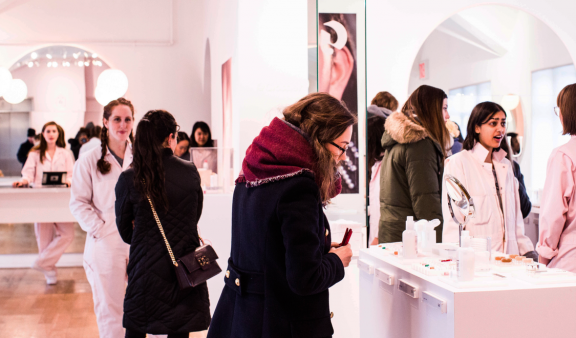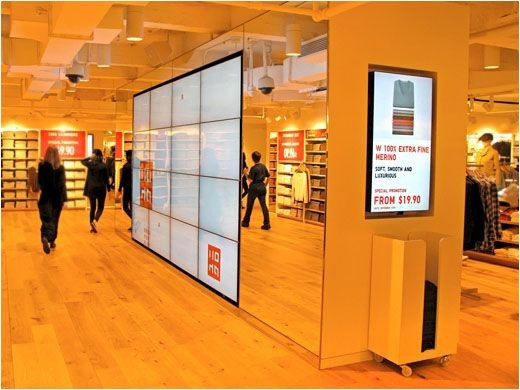
Phygital: How digital is transforming traditional stores and the customer journey
With the e-commerce boom, we are observing changes in practices and a crucial need for complementarity between physical stores and the virtual world of e-commerce and digital technology. This is what is referred to as 'phygital', a portmanteau of 'physical' and 'digital'.
Consumers need to go to stores to physically see products. This is what is observed in certain markets, such as the automotive market.
The end of traditional stores?
While e-commerce is growing rapidly, it represents 10.2% of total retail sales worldwide (source: JDN – March 2018). While this proportion is increasing (8.6% in 2016 and 7.4% in 2015), physical stores remain the favoured purchase method.
However, digital offers major advantages for traditional stores, by boosting footfall and enhancing the in-store customer experience with new digital technologies.
Physical and digital are therefore complementary and not opposed.
One of the best examples is the feedback given by the director of the NRF (National Retail Federation) in the USA at the recent NRF 2019: Retail's Big Show. Held in New York, this show is one of the biggest global events dedicated to retail, new technology and connected commerce.
In 2018, the director of the NRF predicted a catastrophe for physical retailers, with the huge increase of orders on Amazon. Today, we can see that the doomsayers were wrong. Retail has never been in better shape, with a record year and 4.5% growth in the USA in 2018, and the opening of nearly 2000 stores over the course of the year, in particular thanks to the integration of digital technology in the in-store customer experience.
What are the major innovations and benefits of the phygital experience?
New virtually-driven brick and mortar stores automatically recognise customers when they enter, either using artificial intelligence and facial recognition (which poses problems with the GDPR however), or by digital identification via the IoT (connected objects fitted with a chip that identifies customers).
This is already the case, for example, in certain Uniqlo clothing stores, particularly in Japan. At the checkout, instead of scanning bar codes, all articles are placed in a basket and automatically recognised by connected chips inserted in the clothes. This avoids errors, prevents theft and, above all, makes it possible to increase sales by simplifying and speeding up the checkout process.

This is also the case in new Nespresso stores in Europe and the USA: customers select their coffee sleeves and place them in a large container themselves. The total amount to be paid is directly displayed, also thanks to the use of connected chips (or IoT). Customers can pay and leave with their coffee without the need for a checkout assistant. Employees are only there to offer advice on the best choice, which improves the customer experience.

Nespresso store
In the stores of the future, such as those presented at NRF 2019, there will soon be smart cameras able to recognise articles that customers stop in front of (in order to offer them relevant adverts). They will identify which products are placed in baskets or trolleys (without the need for a chip or connected trolley). This will enable customers to keep track of the amount to be paid as they shop and avoid the need to queue when leaving.
Better still, some stores are taking the experience further by allowing customers to leave and be automatically debited for their purchases without going through a checkout. This technological feat is made possible by using artificial intelligence (AI) to recognise customers as they enter and leave the phygital store.

Smart Shelf Stand at NRF 2019 - https://www.youtube.com/watch?v=7Ps1ZIzAw24
The customer experience is enhanced by augmented reality in these next-generation stores. Imagine customers who visit an estate agent to discover their future home. Rather than a simple plan or drawings, augmented reality makes it possible for them to virtually explore the home. Using a tablet and an augmented reality application, they can move around and see the various parts of their future home.
The connected mirrors presented at CES 2019 in Las Vegas offer a similar experience: in a fashion store, customers can try on clothes and make-up in front of a connected mirror without having to go to the changing rooms or beauty bar. Customers choose the clothes and beauty products that suit them best and go immediately to the checkout.

Augmented reality for make-up, Perfect Corp.
All of these innovations (IoT, AI, recognition cameras, augmented reality, etc.) contribute to making stores even more attractive for customers, by transforming their physical experience into a phygital experience.
Phygital: the authentic customer experience 2.0. And all of this is no longer science fiction!
Valérie Guichard
Marketing Strategy and Digital Transformation Consultant
&
Ari Tordjman
Digital Business Development Director, specialised in customer and user experience
SQLI
Every year, SQLI's teams of digital experts attend major global events in the field of digital technology (such as CES Las Vegas and Retail's Big Show in the USA, and Viva Technology in France), and report on the innovations presented. This article covers some of the discoveries made by teams from the SQLI Lab at the 2019 CES and NRF shows.